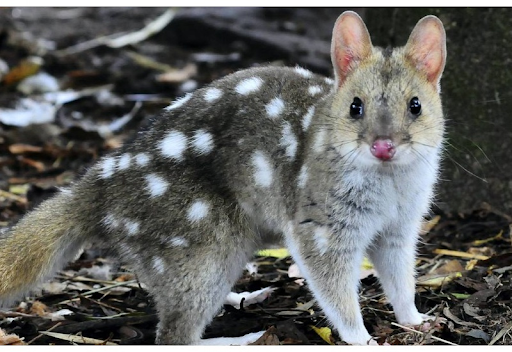
ID CARD
Name : The Tiger Quoll (Dasyurus maculatus) is the biggest carnivorous marsupial within Australia. It belongs to the Dasyuridae familiy, as do other marsupial cats and the Tasmania devil. The species is divided in two subspecies : D. maculatus maculatus and D. maculatus gracilis.
Habitat : As it lives exclusively on the australian continent, their living area spans from southwestern Queensland to eastern New South Wales, from southeastern Australia to Tasmania. They live in dry and wet sclerophyllous forests, as well as in coastal and tropical woodlands, and in pasture.
Size : The species shows sexual dimorphism, males being generally bigger than females, they range from 69 to 113 cm, including their tail.
Way of life : This carnivore’s diet is quite varied, ranging from birds to reptiles, including insects and other marsupials. They reach sexual maturity a year into their life, and can live up to 5 years old.

INTERESTING FACTS ABOUT THIS ANIMAL TO USE WHILE FLIRTING …OR NOT
The Tiger Quoll is a solitary animal. Females don’t tolerate other females except for their children, which they keep in their belly pouch. They however let males come into their territories. They have such large territories that those often overlap on females’.
In spite of this solitary behaviour, they share waste places and birthing spots. Yep, these strange cats have a shared toilet system, not unlike humans. During a female’s reproductive period, she leaves pheromones in common toilets, to attract males passing by. When they find her, they begin to sing bringing a bit of romance to the mix. He strolls around her, snifing her buttocks while she brings her posterior up. When she begins to sing along, the male falls quiet and the hours-long act can begin. Males seem to keep a romantic behaviour all along, caressing her mate all the way. He can also show agressive behaviour, with a bit of neck-biting, leaving slashes, sometimes going all the way and killing his mate. This trait is also shared with the close Tasmanian devil.
Sadly, because of poisoned traps, town development-caused deforestation and habitat loss, the species is classified as ‘‘Near Threatened’’ by IUCN. The habitat fracturing significantly lowers resource access and habitat disponibility, causing frequent encounters among individuals, and therefore greatly increasing intra and inter-species competition. This type of encounter is putting pressure on the species, which is moreover threatened by wildcat and fox introduction, which are predators for the Tiger Quoll.
Written by Léa Prévost
Translated by Arnaud Bichet
Sources :
- https://animaldiversity.org/accounts/Dasyurus_maculatus/
- Jones, Menna E., et al. “Dasyurus Maculatus.” Mammalian Species, no. 676, 2001, pp. 1–9. JSTOR, (LIEN)
- Belcher, C.A. and Darrant, J.P. (2006), Habitat use by tiger quoll (Dasyurus maculatus) (Marsupialia: Dasyuridae) in south‐eastern Australia. Journal of Zoology, 269: 183-190. (LIEN)
- Belcher, C.A. and Darrant, J.P. (2004), Home range and spatial organization of the marsupial carnivore, Dasyurus maculatus maculatus (Marsupialia: Dasyuridae) in south‐eastern Australia. Journal of Zoology, 262: 271-280. (LIEN)
- https://www.iucnredlist.org/species/6300/21946847
- Image reference : https://www.treehugger.com/eastern-quolls-return-mainland-australia-4864388
- Illustration provided by Léa Prévost


Comments are closed